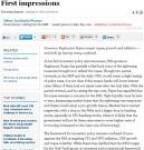Rah rah for wonder boy Rajan

You don’t say!
Darius Nakhoonwala
As a professional reader of editorials, I have for long marvelled at the ease with newspapers change their stands on so many issues. They will be saying “do this” for weeks and then, suddenly, when the opposite of that is done, they will praise that too.
The most recent examples of this are the editorials on monetary policy. Between September 3, when Raghuram Rajan took over as the new RBI Governor, and September 20 when he came out with his first mantra, everyone wrote on it and everyone said the same thing: reduce interest rates by reducing the repo rate so that growth can return. They forgot all about inflation which is the RBI’s primary concern.
The repo rate is the interest rate that the RBI charges commercial banks for lending to them when they run short of funds. The higher it is, the less that is borrowed. Eventually, this means spending also gets reduced. The more it declines, the less will be the pressure on prices.
But since a higher repo rate means lower borrowing, it also means that growth will not pick up immediately because firms do not invest much when the cost of money is high.
But came the September 20 and Rajan raised the repo rate. And what did the editors do, most of them at least? Having hailed him as the new messiah for two weeks, they praised his decision unreservedly. There was no concern for the reader who has been left wondering.
Thus, The Hindu wrote that he had “upheld two hoary traditions of the central bank — the commitment to combat inflation with an unequivocal focus, and the capacity to surprise the markets.” It ended the edit saying “the central bank is continuing to do what it does best — keeping the inflationary demon in check.”
The Hindustan Times view was that “Raghuram Rajan has made his commitment to price control clear.” It had, like The Hindu, till then been arguing for a cut in the repo rate. The only good thing about this edit was that it did not burden the reader with technicalities.
The Times of India said he “had done well to stay focussed on inflation.” It added, “The irrational exuberance on display following the Fed announcement was a bit like calling for champagne because one's liver transplant has been postponed… Rajan refused to keep the economy on artificial stimulants.”
The Business Standard, after explaining some technical things, said that he “has clearly sought to establish his credentials as an inflation fighter and the action should be seen as an indication of how monetary policy will operate during his term.” It did say, however that the RBI had ensured that price of money came down by other means.
The Hindu Business Line played it safe and focussed on the technical aspects.
The Indian Express was the only paper to take a sharply critical line. It said the way in which monetary policy was being made was confusing. “The framework for monetary policy remains confused. It now appears the RBI is targeting CPI and WPI inflation, GDP growth and rupee volatility.” The implication was that this approach would not work.
The Telegraph went off at a completely different angle. It focused on the way the RBI manages India’s forex reserves and suggested that India should emulate Norway! Wow!
Perhaps it will write a more germane edit later in the week. It will be interesting to see what it says. But don’t hold your breath.
Worst of all, the large number of edits on monetary policy written during September 4-21 all showed that by and large the edit writers are not familiar with the RBI’s main responsibility. This is clearly spelt out in the RBI Act as being to maintain the monetary stability of India.
And that means keeping inflation low because if the currency gets debased by inflation we can kiss goodbye to monetary stability.